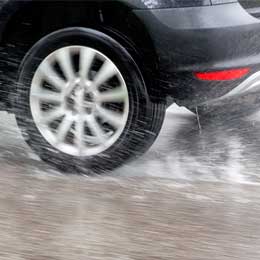 During the summer, weather patterns can change quickly, bringing in torrential downpours. As a result, visibility can be significantly reduced and large amounts of rainwater can collect on our roadways.
During the summer, weather patterns can change quickly, bringing in torrential downpours. As a result, visibility can be significantly reduced and large amounts of rainwater can collect on our roadways.
During rainy conditions, hydroplaning can occur. Hydroplaning is a function of speed, inadequate tire tread, and standing water. Hydroplaning occurs when water on the road causes your tires to lose contact with the road. This loss of contact results in a loss of steering and braking.
Why is hydroplaning so dangerous? When people realize they’re hydroplaning, they panic and start overcorrecting. Overcorrecting too much can send your car veering out of control.
Tips to avoid hydroplaning
1. Don’t use cruise control in the rain. Cruise control is a nice feature, especially if you’re taking a family road trip. In the rain, however, cruise control should not be used. If you’re not paying attention to your speed, hydroplaning can occur.
2. Make sure your tires have adequate tread. Many people mistakenly believe tire tread is for traction. Tire tread actually moves snow or water away from the tires. If tires were all about traction, you’d want a smooth tire.
If you watch NASCAR or the IndyCar Series, you’ll see the tires don’t have treads. That’s because cars handle better at higher rates of speed when more rubber connects with the road.
3. Rotate your tires. Rotating tires at recommended intervals can maintain even tread wear and help you get the maximum life out of your tires. Again, the better the tread, the more effective your tires will be at pushing away snow and water.
4. Don’t wait until your tires are on their deathbed to replace. Tires are expensive and not particularly fun to buy; however, driving on your tires past their useful life puts you and your family in danger.
5. Avoid standing water and puddles. While driving through them may seem like the fun thing to do, it's best just to avoid them.
6. Drive at a safe speed. The faster you drive, the harder it is for your tires to push water away.
7. Pay attention to the cars in front of you. The car in front of you can help you understand the condition of the road. If you see excessive amounts of water coming from their tires, they may be driving in a lane that’s holding excessive water. In this case, you may want to slow down or make a lane change.
Tips to handle hydroplaning
1. Stay calm. Hydroplaning doesn’t last for an extended length of time.
2. Don’t hit the brakes.
3. Don’t oversteer. Only tiny steering inputs may be needed.
4. Gently lift off the gas. This will naturally move the weight to the front of the car, bringing back control.
Do you have any tips or information on tires you’d like to share? I’d love to hear them; please share them in the box below.





